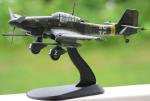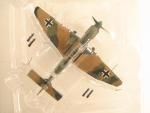Hobby Master Archive
Air Power Propellers 1/72
Ju-87
The Stuka was terror from the sky during the Blitzkrieg of Europe where there was little air opposition. Things changed with the Battle of Britain where they came up against Hurricanes and Spitfires. The much slower Stuka didn’t have a chance against the superior speed and agility of the fighters and suffered heavy losses. The Stukas were removed from the Western Front and sent to the Balkans to assist the Italian Air Force fight the Greeks and Yugoslavians. Frustrated by the inability of the Italian Air Force in North Africa to defeat a force many times smaller in size the German Ju-87’s were assigned to do the job. Here they once again were able to apply the tactics they had first become so well known for. Allied air power was almost non-existent during the early stages of the North African Campaign and the Stuka was able to inflict heavy losses on British troops and equipment. Once Allied aircraft were sent in numbers to North Africa the Stuka once again faltered from lack of speed and their airbases had to be moved further back from the front lines to escape the British artillery. Eventually after heavy losses the Dora’s and other Ju-87’s were withdrawn from North Africa. The Eastern front eventually became a shooting gallery for the Mig’s, Yak’s and numerous other Soviet planes as the Ju-87 was recklessly thrown in to battle with the hopes of turning the fortunes of war.
Because of the slow development of new attack aircraft Germany decided to improve what they already had, the Ju-87. The new and improved version was much more streamlined with an increase of power, so in 1942 all this gave birth to the Dora (D version) with a 1,400 hp Jumo 211 J or P engine. The large and less than aerodynamic cooling radiator was removed from under the engine cowling and replaced with two radiators, one under each wing. A much smaller and less obtrusive oil cooler took the place of the old radiator under the engine cowling. Even a new VS11 propeller with paddle blades was installed which further enhanced the Dora’s performance. They also improved on other features to make the new model more aerodynamic. Previous versions had a canopy that was pretty much the same shape and width along it’s entire length. The “D” version now had the slimmer greenhouse canopy that tapered from the pilot portion back. This tapering wasn’t a real big hit with the rear gunners as it meant more cramped spaces for them. There is no question that the new “D” version was going to be the main Stuka so the Luftwaffe had a large number of versions built or planned. With over 5,000 Stukas built by the end of 1944 the Dora was the dominant one being produced during the latter part of WWII, more than 1500 D-3s were produced. Some more improvements saw the rear gun go from a single drum fed MG15 to a new twin belt fed MG81. The D-3 version was the first version to be completely designed for a close support role. Since the plane would be facing more ground fire the armor for the engine and crew was increased. The landing gear was strengthened and spats were reduced in size making them a much better shape but quite often were removed in the field as they would fill with mud whenever the Stuka had to use a wet dirt strip to operate from and their removal didn’t effect the performance that much. Even with the Stuka’s improved landing gear it was prone to collapse when operated from a rough runways. One of the most notable features of the earlier Ju-87s was removed, the sirens. Even though the D-3 was a ground attack version it kept its dive brakes. The tail fin was enlarged, bomb releases were made more symmetrical and the load was increased to 1800 kg from 1100 kg and one of the new bombs that could be carried was the 1400 kg armor piercing one that could be carried on the center line rack. Some D-3 were converted to G-1 tank killers, some were even converted to D-4 torpedo bombers that never did get used so they were converted back to D-3s. One of the oddest conversions was when they experimented with personnel pods. The pods were mounted on top of the wing, one per wing, each carrying two people. This was going to be used to drop agents for clandestine operations, in theory the Stuka would go into a shallow dive and deploy parachutes that would carry the cargo to a safe landing. As you can imagine the entire proposal was rather questionable and after a few test flights with just the pods it was determined that this was not the answer and the Ju-87 were converted back to the regular D- 3. Some D-3s were even outfitted as D-7 and D-8 for night attack missions.
The Ju-87G was the final version of the Stuka. Stuka (a contraction of the word Sturzkampfflugzeug - dive bomber) There were two versions used as tank busters, the G-1 (G-1s were minimal conversions from D-3s) the G-1 was based on the short-wing span D-3 model while the G-2 (G-2s were rebuilt D-5s that were much cleaner aerodynamically than the G-1), was based on the long-wing span D-5 model. Instead of dive attacks Germany decided to keep the design as it was, but to upgrade the power plant to a Jumo 211J, and add two 30 mm (1.2 in) cannon. The variant was also designed to carry a 1,000 kg (2,200 lb) free-fall bomb load. These weapons fired special armour-piercing ammunition, with tungsten cores, at a muzzle velocity of 850m/sec. They were installed in gun pods fitted outboard of the landing gear legs. The ammunition was in six-round clips per gun. The first operational trials were made in March 1943. The normal 7.9mm or 20mm wing guns were deleted and the holes were covered and this model recreates this. Dive bombing was not possible with the additional weight of the guns, so the dive brakes were also deleted – the Ju-87G could still drop bombs, but not in a dive. Initially, the Ju-87G was seen as quite dangerous to its crews. The additional weight and drag of the wing guns adversely affected performance and handling, and low-level attacks in the face of the Soviet AAA and fighters seemed suicidal. But true as that was, it remained that the Ju-87G was extremely effective. By 1943 the 37mm gun was considered obsolete as an anti-tank gun on the ground, but from the air it was still effective, because the Ju-87G could attack tanks from the rear or from above, were their armour was much thinner. Not that the Germans refrained from trying out bigger cannon on anti-tank aircraft, but the Ju-87 could not possibly carry these, and larger aircraft such as the Ju-88 were not agile enough to operate successfully against tanks. These Gustav models were specialized tank killers, nicknamed the Panzerknacker (tank cracker) or Kanonenvogel (cannon bird). The Panzerknackers were extremely vulnerable to enemy fighters, but they flew on regardless until the end of the war. Production of the Ju-87 was ended in October 1944.
There were two versions of the Ju-87 used as tank busters, the G-1 with the short-wing span of the D-3 model while the G-2 was based on the more aerodynamic long-wing span D-5 model. The power plants were upgraded to Jumo 211J and two 30 mm (1.2 in) cannons added by installing them in gun pods mounted under the wings and fired special armour-piercing ammunition, with tungsten cores, at a muzzle velocity of 850m/sec. The Ju-87G1 was also designed to carry a 1,000 kg (2,200 lb) free-fall bomb load.









